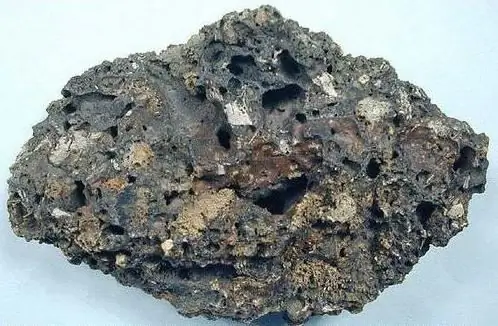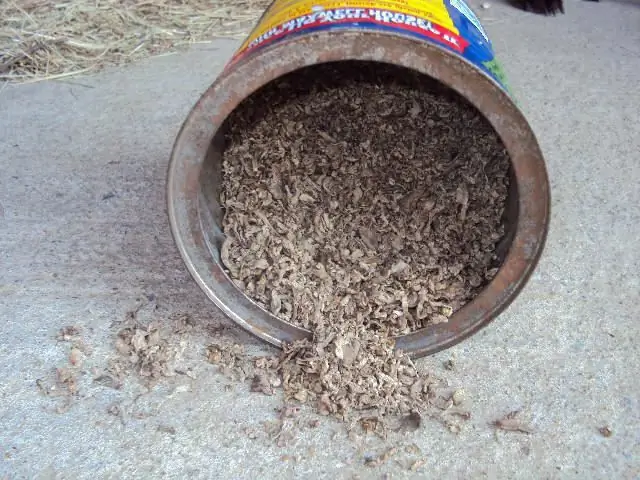2026 Author: Howard Calhoun | [email protected]. Last modified: 2025-01-24 13:10:38
One of the most effective ways to increase the productivity of farm animals is to feed them beet pulp. It contains a huge amount of substances useful for the body of cows, pigs, sheep and goats. In addition, this feed is very easy to distribute to animals using existing production lines on farms.
General Product Description
Beet pulp is the main product of sugar beet processing. There are the following varieties of it:
- Fresh. This is the name of beet pulp that came out of the diffusion apparatus and was stored for no more than a day.
- Sour. After the raw pulp has lain in storage for more than three days, it acquires a sour taste. At the same time, its nutritional value is significantly lost.
- Pressed. This type of product contains 10-12% solids.
- Pressed. This pulp contains more than 12% dry matter.
Also, manufacturers produce beet pulp granulated, the use of which allows you to organize the process of feeding animals in the most rational way. At the moment, such a product is becoming more and more popular. Besides,farms often use ensiled beet pulp fermented using a special technology.

Benefits of using the product as feed
To increase the productivity of farm animals, a lot of proteins are introduced into their diet. However, the absorption of the latter is impossible without carbohydrates. The use of beet pulp and allows you to make up for their deficiency. Compared to other foods high in carbohydrates (molasses, root vegetables), it has the following advantages:
- animals willingly eat it;
- pulp is convenient to store and use;
- relatively low cost and ease of delivery.
In terms of efficiency of use, beet pulp is in no way inferior to molasses, which is very popular among livestock farmers. However, the latter is used only in the liquid state. Therefore, in winter, additional heated rooms have to be equipped for its storage. In addition, it is impossible to distribute molasses to animals using conventional production lines. Give it, dissolved in water, to each cow or pig separately. Which, of course, greatly complicates the care. The pulp can be fed directly along the lines, and strictly dosed.
Root crops (potatoes, beets, etc.) contain more sugars than beet pulp. However, to deliver them to farms, you need to purchase additional transport and hire a certain number of workers. Plus, they cost more.
Thus, the benefits of using pulp are many,and therefore at the moment it is perhaps the most popular type of food with a high content of carbohydrates. In advanced farms, it has been estimated that the use of bagasse increases the profitability of cow farms by 17-25% and pig farms by 40%.

Disadvantages of using
Beet pulp granulated, the use of which is quite justified to increase the productivity of livestock, must be fed in certain quantities. Cows using it, for example, give much more milk. However, milked from those animals that received a very large amount of pulp as feed, it turns sour much faster. At the same time, too hard butter is obtained from such milk, and cheeses ripen for a long time. In calves, an excess of this product causes diarrhea. Therefore, the amount of pulp in the diet of animals should be strictly dosed. The allowable percentage of this type of feed to others included in the diet depends mainly on the age of farm animals.

Regulations
You can feed beet pulp to animals in the following quantities:
- Young cattle - 50 kg per head per day.
- Adult animals - 80-85 kg.
At the same time, you can fatten animals with pulp:
- adults - 80-90 days;
- aged 3-4 years - 90-100 days;
- young animals 1.5-2 years - 100-120days.
When using beet pulp as a fattening agent, roughage in an amount of at least 3-3.5 kg must also be introduced into the diet. Cows, for example, are usually given straw.
Beet pulp production methods: pressing
As already mentioned, this product is made during the production of sugar. Further processing can be carried out by pressing, drying or ensiling. Fresh pulp is sometimes used as food. But it is sold only to those farms that are close to sugar factories.
Beet pulp production involves the use of special horizontal type pressing lines. For example, when using PZHS-57 equipment, about 35% of water is removed from a fresh product. At the same time, the dry matter content increases by 9-10%.
Cooking silage
Fermented beet pulp is also a valuable feed for farm animals. It is ensiled in a "hot" way (with shelter without air access) at a temperature of about 50 gr. Before laying in the pits, the raw material in this case is pressed to remove part of the water. The fact is that excess of the latter slows down the formation of lactic acid. The optimal moisture content of pulp for ensiling is 70-75%. When laying, straw chaff, chaff, chopped corn stalks, etc. can be added to it. To improve the quality, pure cultures of lactic acid bacteria are added to the pulp. Ensiling can be done both in pits and in trenches. Also, the fermentation procedure canproduced in sleeves.

Drying
Of course, pressed and ensiled feed of this variety is fed to animals not in the course of its production. A significant part of it is laid down for storage. Of course, it is undesirable to keep beet pulp raw or even pressed in warehouses. Fermentation processes begin to take place in it rather quickly. As a result, the pulp loses its taste, and its nutritional properties deteriorate significantly. Therefore, special workshops are created at beet factories in which this product is dried. This procedure consists of several stages:
- Squeeze out the beet pulp part of the water. In this case, pulp pressing equipment is also used.
- Actually drying. At this stage, special tower and drum-type machines are used. Drying usually uses the heat from the sugar factory boiler room.
- Briquetting. In this case, pressing equipment is also used. During the briquetting process, a little molasses (about 20%) can be added to the pulp. This significantly increases its nutritional value.
The characteristics of this product, as well as others intended for feeding to animals, are regulated by GOST. Dried beet pulp must contain no more than 14% moisture and no less than 7% protein in terms of dry matter. Sucrose in the composition of this product should include at least 10%. From 100 kg of fresh pulp, 7 kg of dried pulp is obtained.
Beet pulpgranular: production
In bulk dried form, this type of food is quite convenient to store. But only in large agricultural enterprises. Owners of ordinary household plots and small farms prefer to buy granulated beet pulp. In such feeds, among other things, nutrients are distributed more evenly. They also have better digestibility. Such pulp is made using special equipment - granulators and extruders.

Composition of beet pulp
In this valuable feed product (dried):
- dry matter - 86-93%;
- water - 7-14%;
- protein - 7-9%;
- fiber - 19-23%;
- BEV - 55-56%;
- ash - 2.4-4.3%;
- fat - 0.3-0.55.
One kilogram of beet pulp contains 80 g of protein, 3.2 g of amino acids, 6.1 g of lysine, 5 g of calcium, 2 g of phosphorus, 154 g of sugar, 32 g of starch. In addition, this product contains biotin (0.001) and pantothenic acid (0.21). Also, dry beet pulp contains vitamins B1 (0.55 mg/kg), B2 (0.20), B6 (0.18), C (5.0).
Domestic producers of beet pulp
In our country, this type of feed is produced by many enterprises. You can buy it, for example, from Sotnitsyno Sugar Company LLC, established in 2005 on the basis of Sotnitsyno Sugar Plant State Unitary Enterprise.

Also thisThe product is sold by Yaragroresurs LLC, headquartered in Yaroslavl. Granulated sugar beet pulp can also be purchased from Stimul LLC (Stary Oskol), Smile LLC (Lipetsk), Sputnik LLC (Veliky Novgorod), etc.
Rules for storage of dry pulp
The state has recently begun to pay maximum attention to the development of agriculture and, in particular, animal husbandry. New enterprises of this direction are constantly registered in the country. The demand for feed is also growing, including beet pulp. And consequently, its production also increases. A significant part of the dry loose pulp is sent to the farms immediately after production. Some farmers also purchase appropriate equipment and dry on site.

In order for the pulp to retain a large amount of nutrients and substances useful for animals, it should be stored properly. Like most other types of dried food, this product belongs to the group of capillary-porous hygroscopic. Therefore, the humidity of the air in the room where the pulp is stored should in no case exceed 60%. Already at 66%, xerophilic mold begins to develop in this product, at 81% - ordinary, and at 92% - pathogenic bacteria.
Beet pulp, therefore, is the most valuable fodder product, which should be used when growing farm animals. But, of course, it should be added to the diet in reasonable dosages, and it is required to storeright.
Recommended:
Baikal Pulp and Paper Mill: echoes of unsustainable production

The unique Lake Baikal is also affected by environmental issues. One of them is related to the work of the Baikal Pulp and Paper Mill, located in the Slyudyansky district. The plant began operating in 1966 and was closed in 2013. What has been done to restore the ecological situation in the region. How are things today
Production of sugar from sugar beet: technology description

Sugar production is the prerogative of large factories. After all, the technology is quite complex. Raw materials are processed on continuous production lines. As a rule, sugar production facilities are located in close proximity to sugar beet cultivation areas
Granulated blast-furnace slag: production, composition, GOST

The powerful development of metallurgy has led to the fact that a wide variety of raw materials have been used in this area. Naturally, after all operations, waste remains. Blast furnace slag also belongs to this category. Despite this, it is still usable
Reinforced concrete is Concept, definition, production, composition and application

One of the most popular building materials is reinforced concrete. These are durable slabs that are used during the construction of high-rise buildings. The material is able to withstand significant loads. It is not subject to the destructive influence of external adverse factors. Features of reinforced concrete, its production technology and application will be discussed in detail in the article
Tall oil: composition, production, application

Tall oil: physical and chemical properties of the substance, description of the technology of its production. The composition of the compound and the main factors that affect it. Fractionation methods. The use of crude oil and its derivatives

